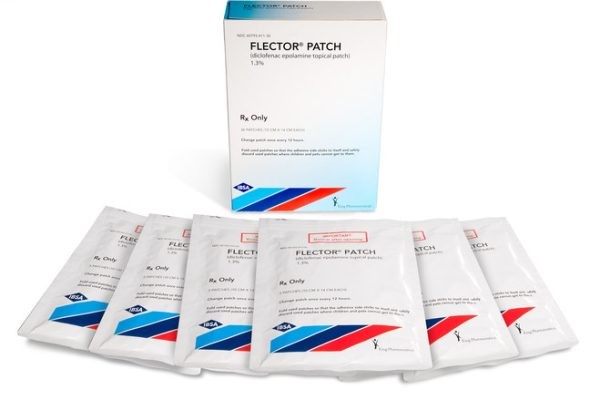
Contents
Flector Patch (diclofenac epolamine)
Flector Patch is a medicine used to treat Arthritis Pain, Acute Pain, Osteoarthritis, and Actinic Keratosis. It may be used alone or with other medications.
Flector Patch belongs to a class of drugs called Topical Skin Products.
It is not known if Flector Patch is safe and effective in children younger than 6 years of age.
What are the side effects of Flector Patch?
RISK OF SERIOUS CARDIOVASCULAR AND GASTROINTESTINAL EVENTS
Cardiovascular Thrombotic Events
- Nonsteroidal anti-inflammatory drugs (NSAIDs) cause an increased risk of serious cardiovascular thrombotic events, including myocardial infarction and stroke, which can be fatal. This risk may occur early in treatment and may increase with duration of use.
- Flector Patch is contraindicated in the setting of coronary artery bypass graft (CABG) surgery.
Gastrointestinal Bleeding, Ulceration, and Perforation
- NSAIDs cause an increased risk of serious gastrointestinal (GI) adverse events including bleeding, ulceration, and perforation of the stomach or intestines, which can be fatal. These events can occur at any time during use and without warning symptoms. Elderly patients and patients with a prior history of peptic ulcer disease and/or GI bleeding are at greater risk for serious GI events.
Flector Patch may cause serious side effects including:
- runny or stuffy nose,
- hives,
- wheezing,
- difficult breathing,
- swelling in your face or throat,
- fever,
- sore throat,
- burning eyes,
- skin pain,
- red or purple skin rash with blistering and peeling,
- chest pain spreading to your jaw or shoulder,
- sudden numbness or weakness on one side of the body,
- slurred speech,
- leg swelling,
- shortness of breath,
- skin rash,
- swelling,
- rapid weight gain,
- bloody or tarry stools,
- coughing up blood,
- vomit that looks like coffee grounds,
- nausea,
- upper stomach pain,
- itching,
- tired feeling,
- flu-like symptoms,
- loss of appetite,
- dark urine,
- clay-colored stools,
- yellowing of the skin or eyes (jaundice),
- little or no urination,
- swelling in your feet or ankles,
- tiredness,
- pale skin,
- unusual tiredness, and
- cold hands and feet
Get medical help right away if you have any of the symptoms listed above.
The most common side effects of Flector Patch include:
- heartburn,
- gas,
- stomach pain,
- nausea,
- vomiting,
- diarrhea,
- constipation, and
- mild itching, burning, redness, or other skin irritation where the patch was worn
Tell the doctor if you have any side effect that bothers you or that does not go away.
These are not all the possible side effects of Flector Patch. For more information, ask your doctor or pharmacist.
Call your doctor for medical advice about side effects. You may report side effects to FDA at 1-800-FDA-1088.
What is the dosage for Flector Patch?
General Dosing Instructions
Use the lowest effective dosage for the shortest duration consistent with individual patient treatment goals.
The recommended dose of Flector is one (1) topical system to the most painful area twice a day both in adults and pediatric patients 6 years of age and older.
Special Precautions
- Inform patients that if Flector begins to peel-off, the edges of the topical system may be taped down. If problems with adhesion persist, patients may overlay the topical system with a mesh netting sleeve, where appropriate (e.g. to secure topical systems applied to ankles, knees, or elbows). The mesh netting sleeve (e.g. Curad Hold Tite, Surgilast Tubular Elastic Dressing) must allow air to pass through and not be occlusive (non-breathable).
- Do not apply Flector to non-intact or damaged skin resulting from any etiology e.g. exudative dermatitis, eczema, infected lesion, burns or wounds.
- Do not wear a Flector when bathing or showering.
- Wash your hands after applying, handling or removing the topical system.
- Avoid eye contact.
- Do not use combination therapy with Flector and an oral NSAID unless the benefit outweighs the risk and conduct periodic laboratory evaluations.
QUESTION
What drugs interact with Flector Patch?
See Table 2 for clinically significant drug interactions with diclofenac.
Table 2: Clinically Significant Drug Interactions with Diclofenac
- Diclofenac and anticoagulants such as warfarin have a synergistic effect on bleeding. The concomitant use of diclofenac and anticoagulants have an increased risk of serious bleeding compared to the use of either drug alone.
- Serotonin release by platelets plays an important role in hemostasis. Case-control and cohort epidemiological studies showed that concomitant use of drugs that interfere with serotonin reuptake and an NSAID may potentiate the risk of bleeding more than an NSAID alone.
- NSAIDs may diminish the antihypertensive effect of angiotensin converting enzyme (ACE) inhibitors, angiotensin receptor blockers (ARBs), or beta-blockers (including propranolol).
- In patients who are elderly, volume-depleted (including those on diuretic therapy), or have renal impairment, co-administration of an NSAID with ACE inhibitors or ARBs may result in deterioration of renal function, including possible acute renal failure. These effects are usually reversible.
- During concomitant use of Flector Patch and ACE-inhibitors, ARBs, or betablockers, monitor blood pressure to ensure that the desired blood pressure is obtained.
- During concomitant use of Flector Patch and ACE-inhibitors or ARBs in patients who are elderly, volume-depleted, or have impaired renal function, monitor for signs of worsening renal function.
- When these drugs are administered concomitantly, patients should be adequately hydrated. Assess renal function at the beginning of the concomitant treatment and periodically thereafter.
Is Flector Patch safe to use while pregnant or breastfeeding?
- Published literature reports that use of NSAIDs, including Flector Patch, after 30 weeks’ gestation increases the risk of premature closure of the fetal ductus arteriosus.
- Data from observational studies regarding potential embryofetal risks of NSAID use, including diclofenac, in women in the first or second trimester of pregnancy are inconclusive.
- Avoid use of NSAIDs, including Flector Patch, in pregnant women starting at 30 weeks of gestation (third trimester).
- Data from published literature reports with oral preparations of diclofenac indicate the presence of small amounts of diclofenac in human milk.
- There are no data on the effects on the breastfed infant, or the effects on milk production.
- The developmental and health benefits of breastfeeding should be considered along with the mother’s clinical need for Flector Patch and any potential adverse effects on the breastfed infant from the Flector Patch or from the underlying maternal condition.
Summary
Flector Patch is a medicine used to treat Arthritis Pain, Acute Pain, Osteoarthritis, and Actinic Keratosis. Serious side effects of Flector Patch include runny or stuffy nose, hives, wheezing, difficult breathing, swelling in your face or throat, fever, sore throat, burning eyes, skin pain, red or purple skin rash with blistering and peeling, chest pain spreading to your jaw or shoulder, sudden numbness or weakness on one side of the body, slurred speech, leg swelling, and others.


